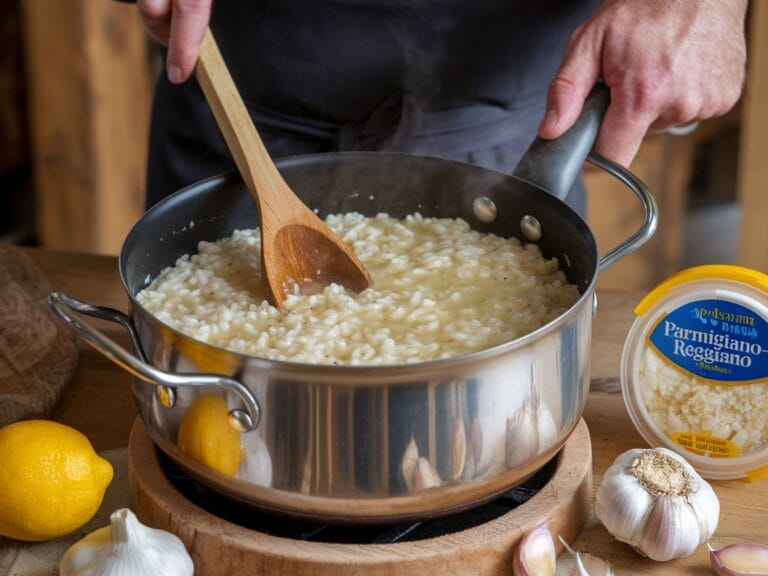Risotto is one of the most beloved Italian dishes, known for its creamy texture and rich flavors. Many think it’s difficult to make, but the real secret to a good risotto lies in mastering a few key techniques. With the right rice, the right method, and a few finishing touches, you can create a dish that’s not only delicious but also incredibly satisfying.
For expert tips on making a risotto that will impress, check out these risotto rules for an impressive dish. Mastering these techniques will ensure you achieve that perfect, creamy consistency every time. 
Essential Techniques for Making a Great Risotto
1. Using the Right Rice
The most important ingredient in any risotto is the rice. Always use Arborio or Carnaroli rice—these short-grain varieties are high in starch, which is essential for creating risotto’s characteristic creamy texture. The starch is released as the rice cooks, making it rich and smooth.
2. Toasting the Rice Properly
Before you start adding any liquid, it’s crucial to toast the rice in butter or olive oil. This simple step ensures that the grains absorb the liquid slowly and evenly, preventing them from becoming mushy. Toasting also enhances the flavor of the rice, giving the dish a delicious nutty undertone.
For a great example of how to use sweet corn in your risotto, check out this sweet corn risotto recipe.
3. Deglazing with Wine
Deglazing the pan with white wine is a classic step in making risotto. This adds a layer of acidity to balance the richness of the dish and helps lift any flavorful bits stuck to the pan. Choose a dry white wine like Sauvignon Blanc or Pinot Grigio for the best results.
Key Steps for the Perfect Risotto Texture
4. Gradually Adding Stock
The secret to a perfectly creamy risotto is adding stock gradually. Always use warm stock and add it one ladle at a time, allowing the rice to absorb the liquid before adding more. This slow absorption is what creates that luscious texture without overcooking the rice.
5. Stirring the Rice
While stirring is important to release the starches, there’s a balance to strike. Stir too much and you’ll cool the risotto down, making it harder to cook. Stir too little, and the rice might stick to the bottom of the pan. Gently stir the rice often, allowing the grains to rub together and release their starch.
6. Keeping the Heat Steady
Maintaining the right temperature is crucial. Keep the heat at a medium simmer throughout the cooking process. Too high and the rice will cook unevenly, too low and it won’t absorb the liquid properly. Adjust the heat as needed to keep a steady simmer going.
Finishing Touches for Risotto Perfection
7. Adding Butter and Parmesan
Once the risotto is cooked, remove it from the heat and stir in cold butter and Parmesan cheese. This final step helps emulsify the dish, making it creamy and velvety. The cold butter adds a luxurious finish, and the Parmesan brings depth and umami to the dish, just like adding butter for richness in the Pumpkin Banana Loaf.
8. Incorporating Fresh Herbs and Acidity
For added brightness, stir in fresh herbs like basil, parsley, or thyme just before serving. A splash of lemon zest or a drizzle of balsamic vinegar can also cut through the richness, adding a layer of acidity that balances the flavors. This balancing act is similar to how acidity can be a key flavor enhancer in baked goods like Earl Grey Cookies.
If you’re looking to perfect your risotto technique, consider signing up for this virtual mushroom risotto class, where you can learn from the experts.
Common Mistakes to Avoid
Overcooking the Rice
One of the biggest mistakes in making risotto is overcooking the rice. The goal is to cook the rice to al dente, meaning the grains should be tender but still have a slight bite to them. Overcooking results in mushy risotto, which loses its creamy consistency.
Adding Too Much Stock at Once
Remember, risotto is not boiled rice. Adding all the stock at once won’t allow the rice to release its starch properly. Always add stock one ladle at a time, allowing it to be fully absorbed before adding more. This method ensures your risotto will turn out creamy, not soupy.
FAQs About Making the Perfect Risotto
What Rice is Best for Risotto?
The best rice for risotto is Arborio or Carnaroli. These short-grain varieties are high in starch, which helps create the creamy consistency risotto is known for.
How Do You Make Risotto Creamy?
Risotto becomes creamy through the slow release of starch from the rice as it absorbs liquid. Stirring frequently and gradually adding stock are key techniques to achieve this texture.
What Can I Add to Risotto for More Flavor?
To add more flavor to risotto, you can incorporate ingredients like mushrooms, shrimp, or asparagus. For a more luxurious touch, consider adding saffron or a drizzle of truffle oil.
Conclusion: Mastering the Art of Risotto
The secret to a good risotto is in the technique. By choosing the right rice, toasting it properly, adding stock gradually, and finishing with butter and Parmesan, you can create a dish that’s perfectly creamy and full of flavor. With practice, you’ll be able to experiment with different flavors and ingredients to make the risotto your own.
For more risotto inspiration, don’t forget to check out this sweet corn risotto recipe or explore other exciting risotto variations!
Print
What is the secret to a good risotto?
Risotto is one of the most beloved Italian dishes, known for its creamy texture and rich flavors. Many think it’s difficult to make, but the real secret to a good risotto lies in mastering a few key techniques. With the right rice, the right method, and a few finishing touches, you can create a dish that’s not only delicious but also incredibly satisfying.
- Total Time: 30 minute
- Yield: 4 servings 1x
Ingredients
- 1 ½ cups Arborio or Carnaroli rice
- 4 cups chicken or vegetable stock (warmed)
- 1 small onion, finely chopped
- 2 cloves garlic, minced
- ½ cup white wine (optional)
- 2 tablespoons butter (plus extra for finishing)
- ½ cup grated Parmesan cheese
- Salt and pepper to taste
- Fresh herbs (parsley, thyme, or basil for garnish)
- 1 teaspoon lemon zest (optional, for brightness)
Instructions
- Sauté Aromatics
- In a large pan, melt 2 tablespoons of butter over medium heat.
- Add chopped onion and garlic, cooking until softened and fragrant (about 3-4 minutes).
- Toast the Rice
- Add the Arborio or Carnaroli rice to the pan, stirring to coat it with the butter and onion mixture.
- Toast the rice for 2-3 minutes until it becomes slightly translucent around the edges.
- Deglaze with Wine
- If using wine, pour it into the pan and cook for 1-2 minutes until the liquid is mostly absorbed.
- Add Stock Gradually
- Begin adding the warm stock, one ladle at a time, stirring frequently. Allow each addition to be absorbed before adding the next.
- Continue this process for about 18-20 minutes until the rice is tender but still slightly firm in the center (al dente).
- Finish with Butter and Parmesan
- Remove the risotto from heat and stir in additional butter and grated Parmesan. This will create a rich, creamy texture.
- Season with salt, pepper, and optional lemon zest for brightness.
- Garnish and Serve
- Serve the risotto hot, garnished with fresh herbs for added flavor.
- Prep Time: 10 minutes
- Cook Time: 25-30 minutes
- Category: Main Course
- Method: Stovetop
- Cuisine: Italian
- Diet: Gluten Free
Keywords: risotto recipe, creamy risotto, perfect risotto, how to make risotto, Arborio rice, Carnaroli rice, Italian risotto, vegetarian risotto, gluten-free risotto


